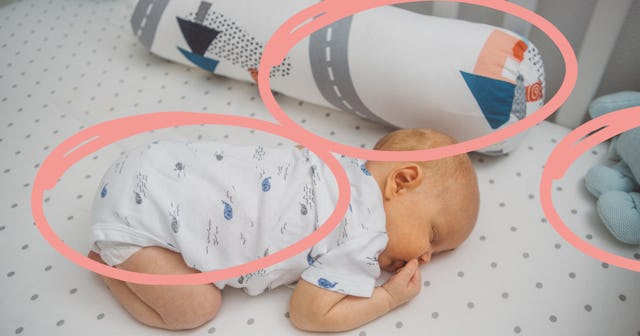Study Finds Many Stock Photos & AI Images Show Unsafe Infant Sleep Practices
Sleep-related infant deaths are up, and parents could be influenced by the images they see on the internet.

At this point in 2025, most people know not to trust everything they see on the internet. We understand that it’s the Wild West out there, and anyone can say anything about anything and call it a fact — even if it’s been exposed as a lie time and time again.
But when you are shown hundreds of images of something, repeatedly, certain ideas might slip into your mind, especially if these images are published by trusted sources like new sites or health resources.
In a new research study conducted by BabyCenter, the parenting resource found that a shocking three out of four stock photos of infants displayed unsafe sleeping environments.
More specifically, an analysis of 500 of the most popular sleeping baby stock photos found that 77% did not meet the safety standards set by the American Academy of Pediatrics (AAP) and could increase the risk of sudden unexpected infant death (SUID).
Just in case you need a refresher, and I know my own mom brain did, a safe sleep environment for infant involves a baby alone, on its back, in a firm crib manufactured to meet current safety standards. The crib should be free on blankets, pillows, and toys, especially soft objects that could promote smothering. The baby should not be laid on a pillow or wedge and the crib should be free of bumpers or related accessories.
Yes, it’s true that bare cribs don’t make for the cutest stock photos of infants sleeping, but adding objects to the area, or featuring a baby and parent sleeping together on a couch can make parents assume that those situations are safe.
The research found that:
- 35% of the pictures featured a blanket in the baby’s crib
- 18% of the pictures featured a pillow in the baby’s crib
- 16% of the pictures featured a soft toy in the baby’s crib
- 16% of the pictures featured a baby sleeping on a soft non-crib surface.
- 12% of the pictures featured a baby sleeping in an adult bed
- 12% of the pictures featured a baby sleeping on its stomach or side.
What can we do about the issue? BabyCenter has take a few step by sharing a collection of doctor-approved photos of infants sleeping safely.
“Major media outlets may use these images for stories about baby sleep — and when they do so, they risk creating a false sense of security about practices that have been linked to sleep-related deaths,” says Olufunke Afolabi-Brown, M.D., a board-certified pediatric sleep physician and leader of BabyCenter’s virtual infant sleep course. “I suspect that most outlets using these photos don’t realize they’re exhibiting unsafe sleep practices. But unfortunately, it sets this expectation that, ‘Well, if the reputable companies that are displaying these photos are using them, then it must be okay.’”
This is especially troubling because the rate of sleep-related infant deaths has started to rise again, about 12 percent according to new data, after falling over the last 20 years.
Experts think that repercussions from the pandemic might be playing a role in the spike, but this is not the first study to find that images in social media are depicting unsafe infant sleep — and normalizing it.
A new issue beyond stock images is the quickly growing popularity of AI images, used both in social media and increasingly by websites and media outlets.
Scary Mommy asked one AI tool to create an image of “a baby sleeping safely in a crib,” and the results definitely did not meet APP guidelines, at all.
The image below, for example shows a baby not on a flat surface, propped on soft blankets, sleeping on its side, and in a “crib” that... let’s just say it does not look safe.
It all makes sense — if AI learns how to make images from what already exists out there, and the majority of pictures of sleeping infants contain SUID risks, AI is going to continue to get it wrong. And in spectacular ways.
It all goes back to this: don’t blankly trust everything you see online, even if you see a picture of a real infant sleeping soundly. The image was taken on a set, by someone not familiar with sleep guidelines. Or else it was produced by artificial intelligence, which at this point isn’t that intelligent at all when it comes to baby sleep safety.